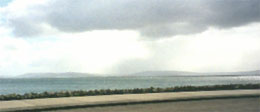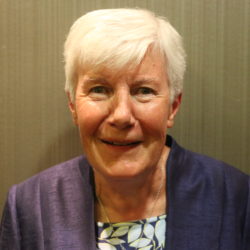 Galway Bay
Galway Bay
Early in 1840 Dr. Browne, Bishop of Galway, commissioned the Parish Priest, Rev. Peter Daly to apply to Baggot Street for a foundation of Mercy Sisters for Galway. There were really no Sisters to spare but Fr. Daly would not take ‘No’ for an answer, and so on 6th May, 1840 Mother McAuley herself accompanied the two Sisters who were to establish a foundation in Galway. They were Sr. Teresa White (Superior) and Sr. Catherine Leahy. They travelled by canal to Tullamore and next day proceeded to Ballinasloe on the canal and from there to Loughrea by long car. They passed the night at the Carmelite Convent there and next day arrived in Galway. They occupied a house in Lombard Street at first and immediately found ample scope for their works of mercy. According to the census of 1841 there were 8,267 adults who could neither read nor write in Galway, and Fr. Daly described his parish thus “The houses in my parish are going to decay, for want of trade and commerce in the town…. There is a change for the worse in the clothing, feeding and habitations of the people” There had been a famine in the 1820’s and it was to come again in the 1840’s; cholera was rampant in the 1830’s and both cholera and typhus were common in famine times.
That was the city that the Sisters of Mercy came to in 1840.
A number of Postulants soon joined them and as well as tending the sick in their homes and hospitals, they visited the jail, taught adults in Sunday School and set up schools for children. In 1842 the convent was transferred to St. Vincent’s, where with major renovations and rebuildings it still survives today. In 1851 they took charge of a Widows’ and Orphans’ asylum, and on the death of Miss Lynch, who had founded the Magdalen Asylum, they had to take charge of the Magdalen Home.
In 1853 Sr. Teresa White accompanied three Sisters to Castlebar where they founded a Convent at the request of the people there. In the 1850’s proselytism was rife in Connemara and throughout the western seaboard, so the Sisters answered a request from Dean McManus of Clifden and five Sisters including Sr. Teresa White went on foundation there. Sr. Teresa White is actually buried in Clifden.
Two years later the Sisters were invited to Oughterard, again to counteract the efforts of proselytisers and ever since they have carried on the work of education and relief of the poor there.
In 1865 they were given charge of the Workhouse Hospital, and over time, as that institution changed and became the Central Hospital, the Regional Hospital and University College Hospital the Sisters proudly and honourably filled many administrative and staff positions until a few years ago. In the field of education too the Sisters were always updating their schools and responding to needs as they arose. In 1884 they started a night school for factory girls and when a building near the Convent became vacant they installed a Book-bindery in one room and a hosiery and knitwear department in another room. Thus poor girls were given work experience which was invaluable in helping them obtain employment. In more modern times they also provided a hostel for Sisters from various Congregations who were attending University and studying for Degrees.
In 1909 Rev. Mark Conroy – Parish Priest of Spiddal approached the Sisters for a foundation there. Lord Killanin offered them a small tract of land and a cottage which was convenient to the Church, and over the years since then the Sisters have provided education at both Primary and Secondary level to the people of the area.
In 1912 they were asked to embark on another endeavour by taking charge of the domestic affairs of St. Mary’s Diocesan College, and they did likewise in Colaiste Einde when that ceased to be a Preparatory College.
After the troubled times of the early 1920’s Lenaboy Castle and estate which overlooked Galway Bay, and had housed the Black & Tan soldiers was for sale. The Sisters purchased it in 1924 and the following year the children from the Orphanage were transferred there and it provided a home for them until 1975 when the modern Group-Homes in Ballyloughane were built to re-locate the orphans.
In more modern times Sisters were responding to calls for service in far, foreign fields. In 1964 a new parish was formed in Merritt Island, Florida, in response to felt needs as expressed by workers at the NASA Space Station in Cape Canaveral. Rev. Sean Molloy, the Irish born Pastor of the new parish requested Sisters to work in the school there and on 24th August, 1964 four Sisters from Galway courageously answered his request. Over the years other Sisters joined them and some returned to Ireland but some Sisters still minister there.
Since Vatican II other smaller communities have been set up in response to needs as expressed locally, but the Sisters respond graciously always. They have never lost the spirit which Dr. Michael Browne spoke of at their Centenary celebrations: “It is the fashion nowadays to imagine that the women of the early Victorian period were very timid, fragile creatures who shrank from what are called the realities of life. There was no timidity about these women who proposed to spend their lives visiting the cabins of the poor, the fever hospital and the jail. It was not a very attractive life yet they were soon joined by young girls who left comfortable homes to follow the same vision.” The Galway Sisters still have that same spirit.
GORT: In 1832 the parishes of Kiltartan and Kilmacduagh were fused to form one parish – Gort. Bishop Fallon was anxious to procure Sisters who would work to relieve the poor and sick of the area and he purchased Bridge House, the former home of Lord Gort for them in 1857. On 4th November, 1857, five Sisters were happily welcomed to the area. They were led by Sr. Aloysius Doyle, a veteran of the Crimean War and in 1904 having been decorated by Queen Victoria, she was induced to write her memoirs of the carnage there. In Gort however, she had many demands on her charity, and with the other Sisters they strove to relieve suffering wherever they could. Many young Sisters joined them, but alas many also died young. Their first schools were modest buildings already in existence but after about thirty years they acquired very good premises which were renowned for the quality of the schooling the young people received. The Sisters modernised their chapel too, and it is a gem renowned for its stained glass and altar of carrara marble. They had a renowned industrial department attached to their school since 1864. Lady Gregory was so impressed with it that she took Horace Plunkett to see it in 1897. New schools replaced the original buildings and after some time the Sisters were able to send a foundation to Ennistymon on 19th March, 1871. Education was their main work there and there are good records of their fund-raising efforts which were rewarded when in 1874, Bishop McEvilly of Galway, laid the foundation stone for their new buildings.
We are told that there was some dispute between the Bishops of Galway and Killaloe, and the Gort Sisters found travel between Gort and Ennistymon inconvenient, and so were anxious to dispose of the Ennistymon Convent. At the same time they were requested to open a house in Kinvara, a seaside village much nearer them, with a population of 700, but many of the inhabitants were in poverty, but very anxious to acquire education. So, on Sunday 28th April, 1878, four Sisters led once again by Sr. Aloysius Doyle took up their abode in a premises which had been acquired through the kindness of the Murray family and on land donated by Mr Blake Forster of Galway. The Sisters immediately supplied a good Primary education and in 1921 when they acquired Seamount House they started a boarding school and had a thriving Secondary Top at first. After a few years this became a full class A Secondary school which is still thriving today.
Further afield the citizens of the USA were very anxious to get Irish Sisters to staff their Catholic Schools and Fr. John O’Hare, the pastor of Titusville, Florida, came to Gort in search of Sisters who were willing and able to undertake this task. His journey was not in vain and on 12th November, 1961 three Sisters departed for Titusville. The following year another Sister joined them and so great was the need as the school was growing so quickly that in 1964 three more Sisters joined them. That school still flourishes but there are not as many Sisters there now as there once was.

Ennistymon we have already mentioned, but whatever the reason for the withdrawal of the Gort Sisters, Ennistymon was not left without Sisters, as the Ennis Sisters bought it from Gort at a cost of £3,500. The Ennis Sisters took possession on 3rd June, 1878. It is a lovely Convent, situated on a hill, within two miles of the sea. In April 1884, Ennistymon became a separate foundation. There were ten Sisters in the community at the time and they formally signed a deed of transfer, as Ennistymon is in Galway diocese and Ennis belongs to Killaloe diocese. Over the years Ennistymon flourished. The Sisters took charge of the District Hospital in 1888. They built new schools and even as late as 1979 provided a completely new Secondary School. Sadly that Convent was hit by lightning in October 1996, and the Sisters had to vacate it for a smaller residence.
Tivoli House, Lisdoonvarna, came on the market in 1948, at a time when demand for Secondary education was deeply felt everywhere. This house was in a convenient location and the Ennistymon Sisters were glad to accede to the peoples’ request. They built a lovely new school there in 1964 and it had to be extended in 1984, and the Sisters are still very much involved in both education and other good works there.
The event of the century that had the greatest impact on religious life was the Second Vatican Council and in Galway Diocese as in other dioceses around Ireland, it was considered that an amalgamation of all houses under one Superior, would be the most effective way of implementing the principles of renewal. Accordingly, after preparation the first General Chapter of the combined communities of Galway Diocese was held in Cluain Mhuire, Galway, and on the 26th November, 1972 the Decree of Union was promulgated and Sr. Baptist Egan became the first Superior of the new congregation. Since that time many changes have taken place. Older Convents have been closed and Sisters have moved to smaller more accessible houses nearer to the people with whom they work. We hope that we have lived up to the tradition of our Holy Foundress, and we praise the Lord for His goodness to us.
Achonry | Ardagh & Clonmacnois | Clonfert | Elphin | Galway | Killala | Tuam


